Successful Application of Eucalyptus Camdulensis Biochar in the Batch Adsorption of Crystal Violet and Methylene Blue Dyes from Aqueous Solution
Abstract
1. Introduction
2. Materials and Methods
3. Results and Discussion
3.1. Characteristics of the Ec-Bio
- EDX spectroscopy and SEM analyses
- FTIR spectroscopy analyses
3.2. Measurement of the Equilibrium Contact Time and Effects of Temperature (Thermodynamic Studies)
3.3. Influence of the Dose of Ec-Bio, Initial Solution pH, and Dye Concentrations of on the Adsorption Performance
3.4. Adsorption Kinetics of Both Dyes onto the Ec-Bio
3.5. Two-Parameter Isotherm Models to Describe the Adsorption Process
4. Conclusions
Author Contributions
Funding
Data Availability Statement
Acknowledgments
Conflicts of Interest
References
- Chowdhary, P.; Bharagava, R.N.; Mishra, S.; Khan, N. Role of Industries in Water Scarcity and Its Adverse Effects on Envi-ronment and Human Health. In Environmental Concerns and Sustainable Development: Volume 1: Air, Water and Energy Resources; Shukla, V., Kumar, N., Eds.; Springer: Singapore, 2020; pp. 235–256. [Google Scholar]
- Abd-Elhamid, A.I.; Emran, M.; El-Sadek, M.H.; El-Shanshory, A.A.; Soliman, H.M.A.; Akl, M.A.; Rashad, M. Enhanced removal of cationic dye by eco-friendly activated biochar derived from rice straw. Appl. Water Sci. 2020, 10, 45. [Google Scholar] [CrossRef]
- Goswami, M.; Chaturvedi, P.; Sonwani, R.K.; Gupta, A.D.; Singhania, R.R.; Giri, B.S.; Rai, B.N.; Singh, H.; Yadav, S.; Singh, R.S. Application of Arjuna (Terminalia arjuna) seed biochar in hybrid treatment system for the bioremediation of Congo red dye. Bioresour. Technol. 2020, 307, 123203. [Google Scholar] [CrossRef]
- Turhan, K.; Ozturkcan, S.A. Decolorization and Degradation of Reactive Dye in Aqueous Solution by Ozonation in a Semi-batch Bubble Column Reactor. Water Air Soil Pollut. 2013, 224, 1–13. [Google Scholar] [CrossRef]
- Geis, S.W.; Fleming, K.L.; Korthals, E.T.; Searle, G.; Reynolds, L.; Karner, D.A. Modifications to the algal growth inhibition test for use as a regulatory assay. Environ. Toxicol. Chem. 2000, 19, 36–41. [Google Scholar] [CrossRef]
- Mittal, A.; Mittal, J.; Malviya, A.; Kaur, D.; Gupta, V. Adsorption of hazardous dye crystal violet from wastewater by waste materials. J. Colloid Interface Sci. 2010, 343, 463–473. [Google Scholar] [CrossRef] [PubMed]
- El-Sayed, G.O. Removal of methylene blue and crystal violet from aqueous solutions by palm kernel fiber. Desalination 2011, 272, 225–232. [Google Scholar] [CrossRef]
- Kulkarni, M.R.; Revanth, T.; Acharya, A.; Bhat, P. Removal of Crystal Violet dye from aqueous solution using water hyacinth: Equilibrium, kinetics and thermodynamics study. Resour. Effic. Technol. 2017, 3, 71–77. [Google Scholar] [CrossRef]
- Ciardelli, G.; Corsi, L.; Marcucci, M. Membrane separation for wastewater reuse in the textile industry. Resour. Conserv. Recycl. 2001, 31, 189–197. [Google Scholar] [CrossRef]
- Zahrim, A.; Dexter, Z.; Joseph, C.; Hilal, N. Effective coagulation-flocculation treatment of highly polluted palm oil mill biogas plant wastewater using dual coagulants: Decolourisation, kinetics and phytotoxicity studies. J. Water Process. Eng. 2017, 16, 258–269. [Google Scholar] [CrossRef]
- Škodič, L.; Vajnhandl, S.; Valh, J.V.; Željko, T.; Vončina, B.; Lobnik, A. Comparative Study of Reactive Dyes Oxidation by H2O2/UV, H2O2/UV/Fe2+ and H2O2/UV/Fe° Processes. Ozone Sci. Eng. 2016, 39, 14–23. [Google Scholar] [CrossRef]
- Feddal, I.; Ramdani, A.; Taleb, S.; Gaigneaux, E.M.; Batis, N.; Ghaffour, N. Adsorption capacity of methylene blue, an organic pollutant, by montmorillonite clay. Desalin. Water Treat. 2013, 52, 2654–2661. [Google Scholar] [CrossRef]
- Bhatnagar, A.; Sillanpää, M. Utilization of agro-industrial and municipal waste materials as potential adsorbents for water treatment—A review. Chem. Eng. J. 2010, 157, 277–296. [Google Scholar] [CrossRef]
- Amin, M.; Alazba, A.; Shafiq, M. Effective adsorption of methylene blue dye using activated carbon developed from the rosemary plant: Isotherms and kinetic studies. Desalin. Water Treat. 2017, 74, 336–345. [Google Scholar] [CrossRef]
- Hagemann, N.; Spokas, K.; Schmidt, H.-P.; Kägi, R.; Böhler, M.; Bucheli, T. Activated Carbon, Biochar and Charcoal: Linkages and Synergies across Pyrogenic Carbon’s ABCs. Water 2018, 10, 182. [Google Scholar] [CrossRef]
- Sen, T.K. Review on Dye Removal from Its Aqueous Solution into Alternative Cost Effective and Non-Conventional Ad-sorbents. J. Chem. Process Eng. 2013, in press. [Google Scholar] [CrossRef]
- Zhang, T.; Zhu, X.; Shi, L.; Li, J.; Li, S.; Lü, J.; Li, Y. Efficient removal of lead from solution by celery-derived biochars rich in alkaline minerals. Bioresour. Technol. 2017, 235, 185–192. [Google Scholar] [CrossRef] [PubMed]
- Amin, M.T.; Alazba, A.A.; Shafiq, M. Adsorptive Removal of Reactive Black 5 from Wastewater Using Bentonite Clay: Isotherms, Kinetics and Thermodynamics. Sustainability 2015, 7, 15302–15318. [Google Scholar] [CrossRef]
- Ahmad, M.; Usman, A.R.A.; Rafique, M.I.; Al-Wabel, M.I. Engineered biochar composites with zeolite, silica, and nano-zerovalent iron for the efficient scavenging of chlortetracycline from aqueous solutions. Environ. Sci. Pollut. Res. 2019, 26, 15136–15152. [Google Scholar] [CrossRef]
- Daful, A.G.; Chandraratne, M.R. Biochar Production from Biomass Waste-Derived Material. In Encyclopedia of Renewable and Sustainable Materials; Elsevier: Amsterdam, The Netherlands, 2020; pp. 370–378. [Google Scholar]
- Patra, J.M.; Panda, S.S.; Dhal, N.K. Biochar as a low-cost adsorbent for heavy metal removal: A review. Int. J. Res. Biosci. 2017, 6, 1–7. [Google Scholar]
- Ahmad, A.; Khan, N.; Giri, B.S.; Chowdhary, P.; Chaturvedi, P. Removal of methylene blue dye using rice husk, cow dung and sludge biochar: Characterization, application, and kinetic studies. Bioresour. Technol. 2020, 306, 123202. [Google Scholar] [CrossRef]
- Gardazi, S.M.H.; Butt, T.A.; Rashid, N.; Pervez, A.; Mahmood, Q.; Shah, M.M.; Bilal, M. Effective adsorption of cationic dye from aqueous solution using low-cost corncob in batch and column studies. Desalin. Water Treat. 2016, 57, 28981–28998. [Google Scholar] [CrossRef]
- Li, G.; Zhu, W.; Zhang, C.; Zhang, S.; Liu, L.; Zhu, L.; Zhao, W. Effect of a magnetic field on the adsorptive removal of meth-ylene blue onto wheat straw biochar. Bioresour. Technol. 2016, 206, 16–22. [Google Scholar] [CrossRef]
- Banik, C.; Lawrinenko, M.; Bakshi, S.; Laird, D.A. Impact of Pyrolysis Temperature and Feedstock on Surface Charge and Functional Group Chemistry of Biochars. J. Environ. Qual. 2018, 47, 452–461. [Google Scholar] [CrossRef] [PubMed]
- Rashid, S.A.; Othman, R.N.I.R.; Hussein, M.Z. Synthesis, Technology and Applications of Carbon Nanomaterials; Elsevier: Amsterdam, The Netherlands, 2018. [Google Scholar]
- Doğan, M.; Alkan, M.; Demirbaş, Ö.; Özdemir, Y.; Özmetin, C. Adsorption kinetics of maxilon blue GRL onto sepiolite from aqueous solutions. Chem. Eng. J. 2006, 124, 89–101. [Google Scholar] [CrossRef]
- Alkan, M.; Doğan, M.; Turhan, Y.; Demirbaş, Ö.; Turan, P. Adsorption kinetics and mechanism of maxilon blue 5G dye on sepiolite from aqueous solutions. Chem. Eng. J. 2008, 139, 213–223. [Google Scholar] [CrossRef]
- Ghaedi, M.; Hossainian, H.; Montazerozohori, M.; Shokrollahi, A.; Shojaipour, F.; Soylak, M.; Purkait, M. A novel acorn based adsorbent for the removal of brilliant green. Desalination 2011, 281, 226–233. [Google Scholar] [CrossRef]
- Nandi, B.; Goswami, A.; Purkait, M. Adsorption characteristics of brilliant green dye on kaolin. J. Hazard. Mater. 2008, 161, 387–395. [Google Scholar] [CrossRef] [PubMed]
- Chowdhury, S.; Mishra, R.; Saha, P.; Kushwaha, P. Adsorption thermodynamics, kinetics and isosteric heat of adsorption of malachite green onto chemically modified rice husk. Desalination 2011, 265, 159–168. [Google Scholar] [CrossRef]
- Hamdaoui, O. Dynamic sorption of methylene blue by cedar sawdust and crushed brick in fixed bed columns. J. Hazard. Mater. 2006, 138, 293–303. [Google Scholar] [CrossRef] [PubMed]
- Taty-Costodes, V.; Fauduet, H.; Porte, C.; Delacroix, A. Removal of Cd(II) and Pb(II) ions, from aqueous solutions, by adsorption onto sawdust of Pinus sylvestris. J. Hazard. Mater. 2003, 105, 121–142. [Google Scholar] [CrossRef]
- Tang, H.; Zhou, W.; Zhang, L. Adsorption isotherms and kinetics studies of malachite green on chitin hydrogels. J. Hazard. Mater. 2012, 209–210, 218–225. [Google Scholar] [CrossRef] [PubMed]
- Gunay, A. Application of nonlinear regression analysis for ammonium exchange by natural (Bigadiç) clinoptilolite. J. Hazard. Mater. 2007, 148, 708–713. [Google Scholar] [CrossRef] [PubMed]
- Manohar, D.; Noeline, B.; Anirudhan, T. Adsorption performance of Al-pillared bentonite clay for the removal of cobalt(II) from aqueous phase. Appl. Clay Sci. 2006, 31, 194–206. [Google Scholar] [CrossRef]
- Rajoriya, R.K.; Prasad, B.; Mishra, I.M.; Wasewar, K.L. Adsorption of Benzaldehyde on Granular Activated Carbon: Kinetics, Equilibrium, and Thermodynamic. Chem. Biochem. Eng. Q. 2007, in press. [Google Scholar]
- Zaghouane-Boudiaf, H.; Boutahala, M.; Arab, L. Removal of methyl orange from aqueous solution by uncalcined and calcined MgNiAl layered double hydroxides (LDHs). Chem. Eng. J. 2012, 187, 142–149. [Google Scholar] [CrossRef]
- Aksu, Z.; Tezer, S. Exploited Application of Bacillus sp. ETL-A & Pseudomonas sp. ETL-B in Microbial Degradation of Orange 16 Dye. Process Biochem. 2014, 36, 431–439. [Google Scholar]
- Chiou, M.-S.; Li, H.-Y. Equilibrium and kinetic modeling of adsorption of reactive dye on cross-linked chitosan beads. J. Hazard. Mater. 2002, 93, 233–248. [Google Scholar] [CrossRef]
- Hamdaoui, O.; Naffrechoux, E. Modeling of adsorption isotherms of phenol and chlorophenols onto granular activated carbon: Part I. Two-parameter models and equations allowing determination of thermodynamic parameters. J. Hazard. Mater. 2007, 147, 381–394. [Google Scholar] [CrossRef] [PubMed]
- Mestre, A.; Pires, J.; Nogueira, J.; Carvalho, A. Activated carbons for the adsorption of ibuprofen. Carbon 2007, 45, 1979–1988. [Google Scholar] [CrossRef]
- Önal, Y.; Akmil-Başar, C.; Sarıcı-Özdemir, Ç. Elucidation of the naproxen sodium adsorption onto activated carbon pre-pared from waste apricot: Kinetic, equilibrium and thermodynamic characterization. J. Hazard. Mater. 2007, 148, 727–734. [Google Scholar] [CrossRef]
- Baccar, R.; Sarrà, M.; Bouzid, J.; Feki, M.; Blánquez, P. Removal of pharmaceutical compounds by activated carbon prepared from agricultural by-product. Chem. Eng. J. 2012, 211–212, 310–317. [Google Scholar] [CrossRef]
- Tan, I.; Ahmad, A.; Hameed, B. Adsorption isotherms, kinetics, thermodynamics and desorption studies of 2,4,6-trichlorophenol on oil palm empty fruit bunch-based activated carbon. J. Hazard. Mater. 2009, 164, 473–482. [Google Scholar] [CrossRef]
- Foo, K.Y.; Hameed, B.H. Preparation, characterization and evaluation of adsorptive properties of orange peel based activated carbon via microwave induced K2CO3 activation. Bioresour. Technol. 2012, 104, 679–686. [Google Scholar] [CrossRef]
- Malik, P. Use of activated carbons prepared from sawdust and rice-husk for adsorption of acid dyes: A case study of Acid Yellow 36. Dye. Pigment. 2003, 56, 239–249. [Google Scholar] [CrossRef]
- Kumar, P.S.; Ramakrishnan, K.; Gayathri, R. Removal of Nickel(II) from Aqueous Solutions by Ceralite IR 120 Cationic Ex-change Resins. J. Eng. Sci. Technol. 2010, 5, 232–243. [Google Scholar]
- Ramadoss, R.; Subramaniam, D. Removal of divalent nickel from aqueous solution using blue-green marine algae: Adsorption modeling and applicability of various isotherm models. Sep. Sci. Technol. 2019, 54, 943–961. [Google Scholar] [CrossRef]
- Saadi, R.; Saadi, Z.; Fazaeli, R. Determination of axial dispersion and overall mass transfer coefficients for Ni (II) adsorption on nanostructured γ-alumina in a fixed bed column: Experimental and modeling studies. Desalin. Water Treat. 2015, 53, 2193–2203. [Google Scholar] [CrossRef]
- Dawood, S.; Sen, T.K.; Phan, C. Synthesis and characterization of slow pyrolysis pine cone bio-char in the removal of organic and inorganic pollutants from aqueous solution by adsorption: Kinetic, equilibrium, mechanism and thermodynamic. Bioresour. Technol. 2017, 246, 76–81. [Google Scholar] [CrossRef]
- Kyi, P.P.; Quansah, J.O.; Lee, C.-G.; Moon, J.-K.; Park, S.-J. The Removal of Crystal Violet from Textile Wastewater Using Palm Kernel Shell-Derived Biochar. Appl. Sci. 2020, 10, 2251. [Google Scholar] [CrossRef]
- Zubair, M.; Mu’Azu, N.D.; Jarrah, N.; Blaisi, N.I.; Aziz, H.A.; Al-Harthi, M.A. Adsorption Behavior and Mechanism of Methylene Blue, Crystal Violet, Eriochrome Black T, and Methyl Orange Dyes onto Biochar-Derived Date Palm Fronds Waste Produced at Different Pyrolysis Conditions. Water Air Soil Pollut. 2020, 231, 240. [Google Scholar] [CrossRef]
- Wathukarage, A.; Herath, I.; Iqbal, M.C.M.; Vithanage, M. Mechanistic understanding of crystal violet dye sorption by woody biochar: Implications for wastewater treatment. Environ. Geochem. Health 2019, 41, 1647–1661. [Google Scholar] [CrossRef] [PubMed]
- Fan, S.; Wang, Y.; Wang, Z.; Tang, J.; Tang, J.; Li, X. Removal of methylene blue from aqueous solution by sewage sludge-derived biochar: Adsorption kinetics, equilibrium, thermodynamics and mechanism. J. Environ. Chem. Eng. 2017, 5, 601–611. [Google Scholar] [CrossRef]
- Sewu, D.; Jung, H.; Kim, S.S.; Lee, D.S.; Woo, S.H. Decolorization of cationic and anionic dye-laden wastewater by steam-activated biochar produced at an industrial-scale from spent mushroom substrate. Bioresour. Technol. 2019, 277, 77–86. [Google Scholar] [CrossRef] [PubMed]
- Mahdi, Z.; Hanandeh, A.E.; Yu, Q. Influence of Pyrolysis Conditions on Surface Characteristics and Methylene Blue Adsorption of Biochar Derived from Date Seed Biomass. Waste Biomass Valoriz. 2017, 8, 2061–2073. [Google Scholar] [CrossRef]
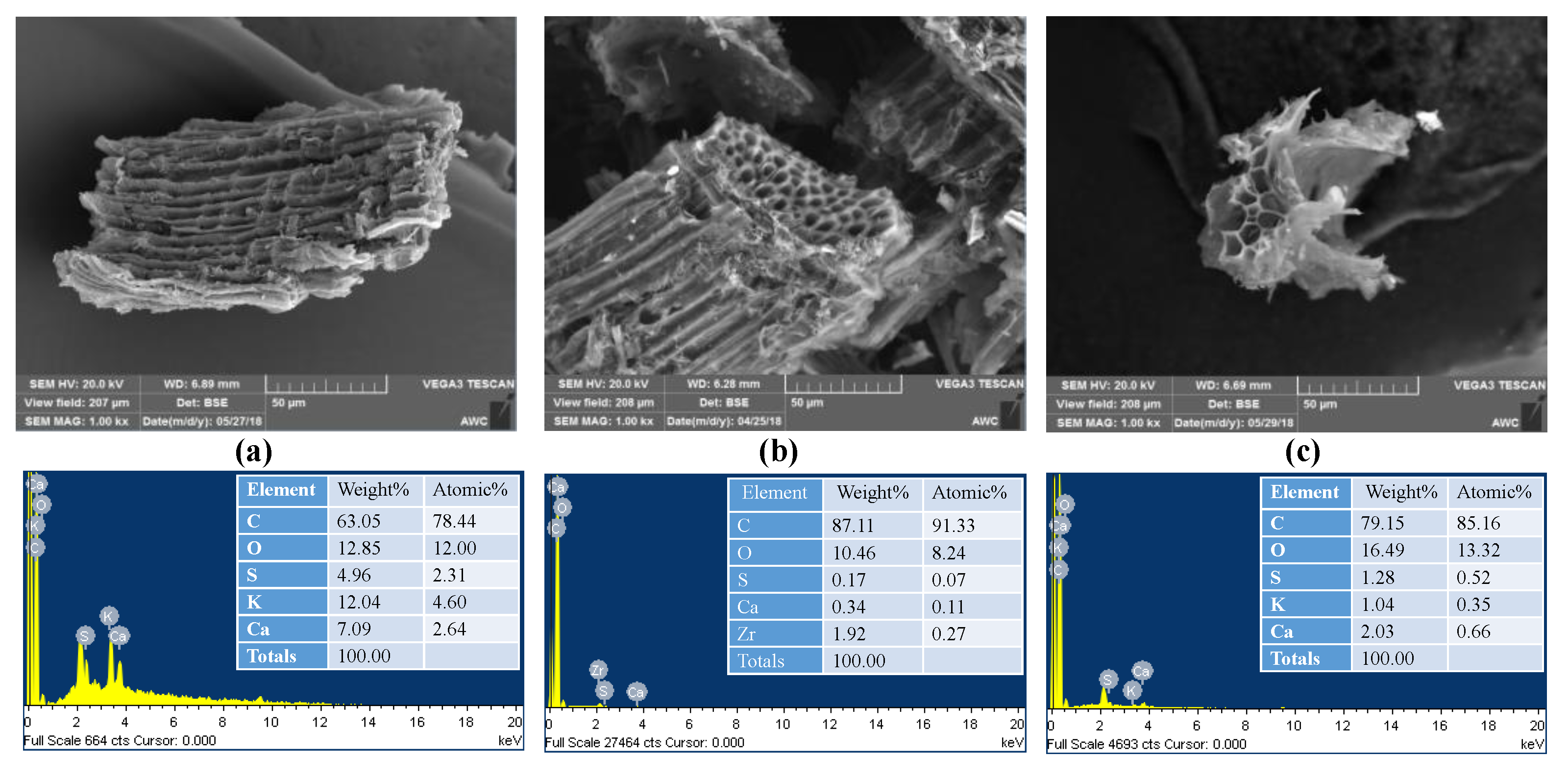
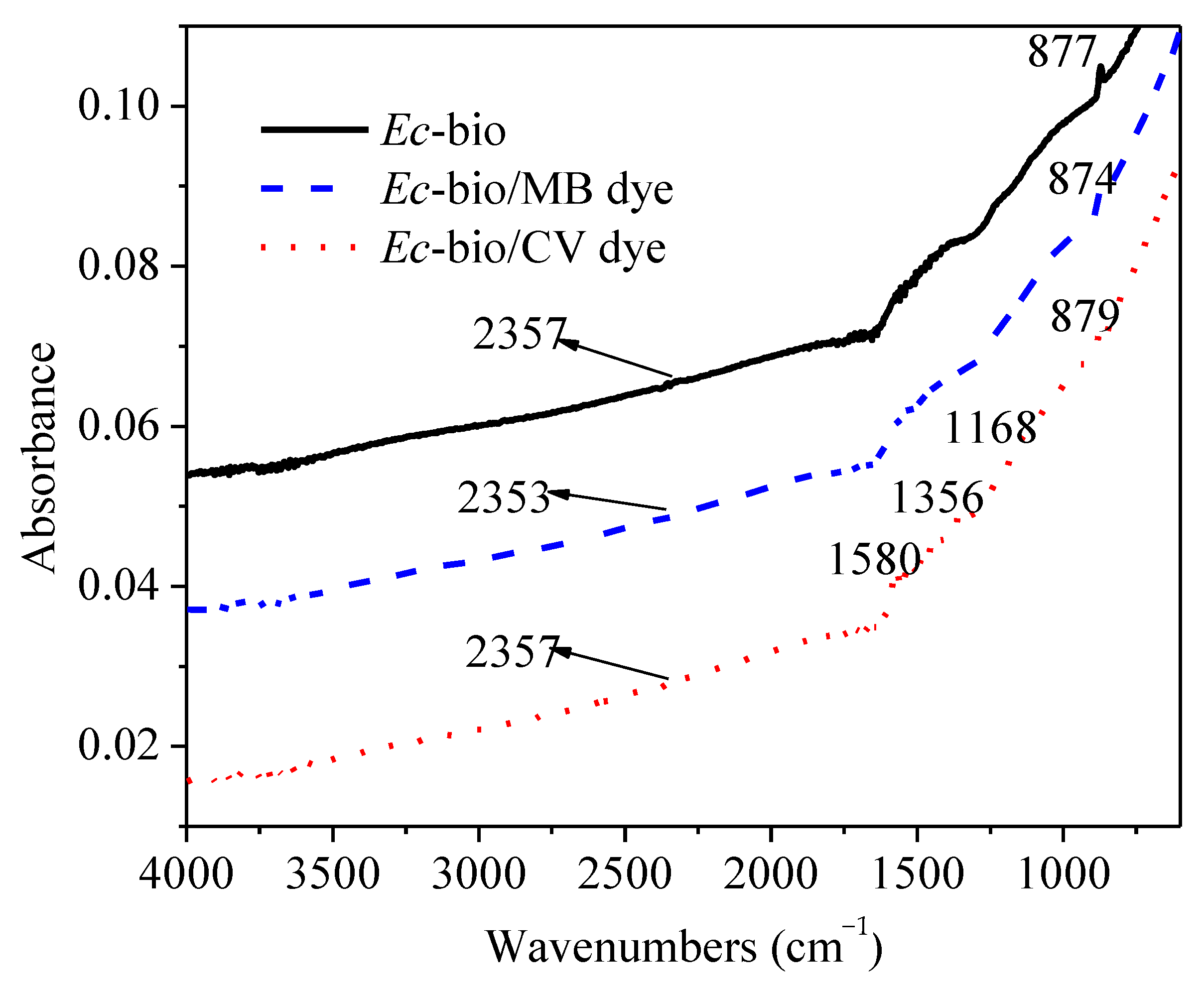
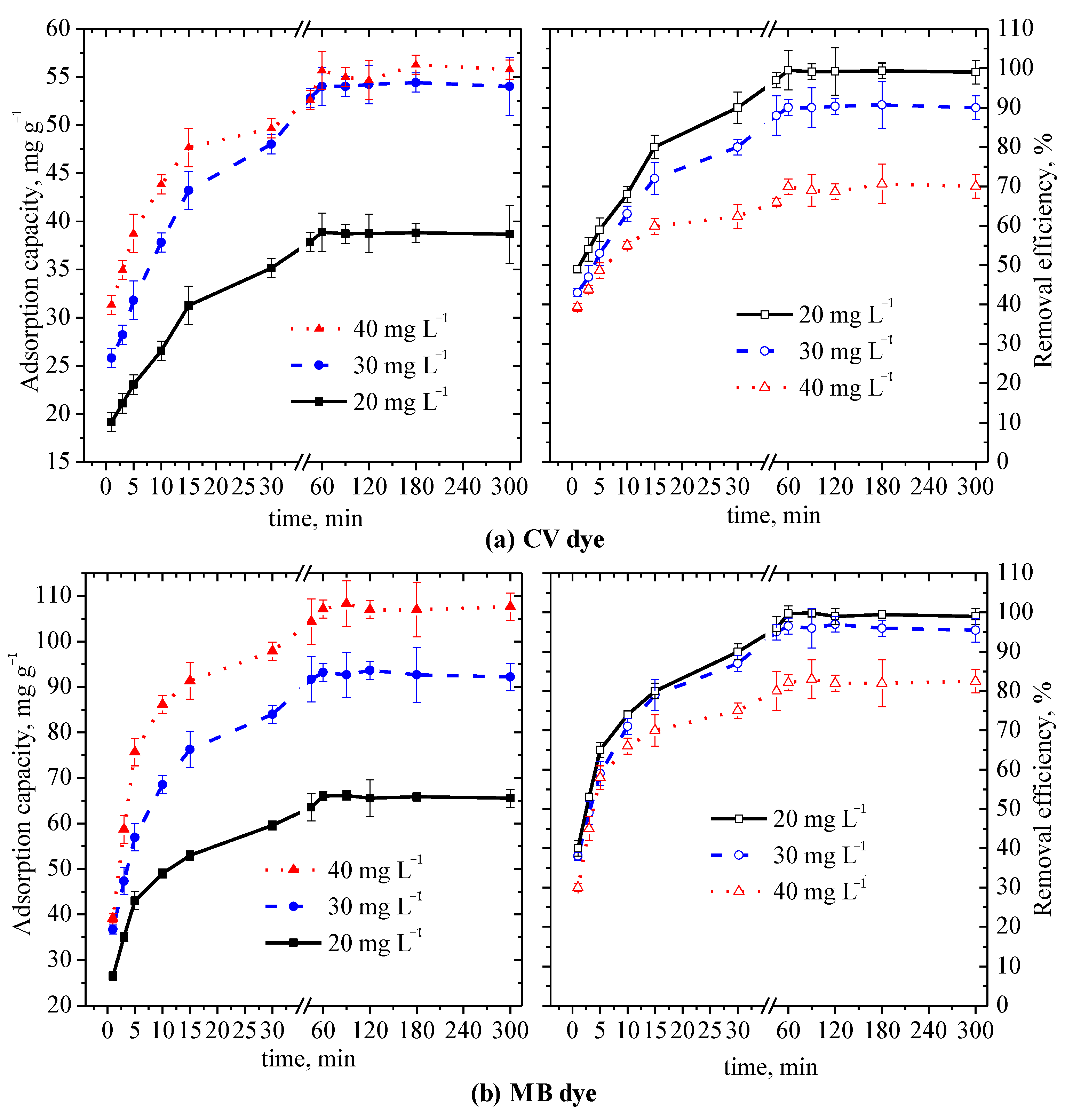
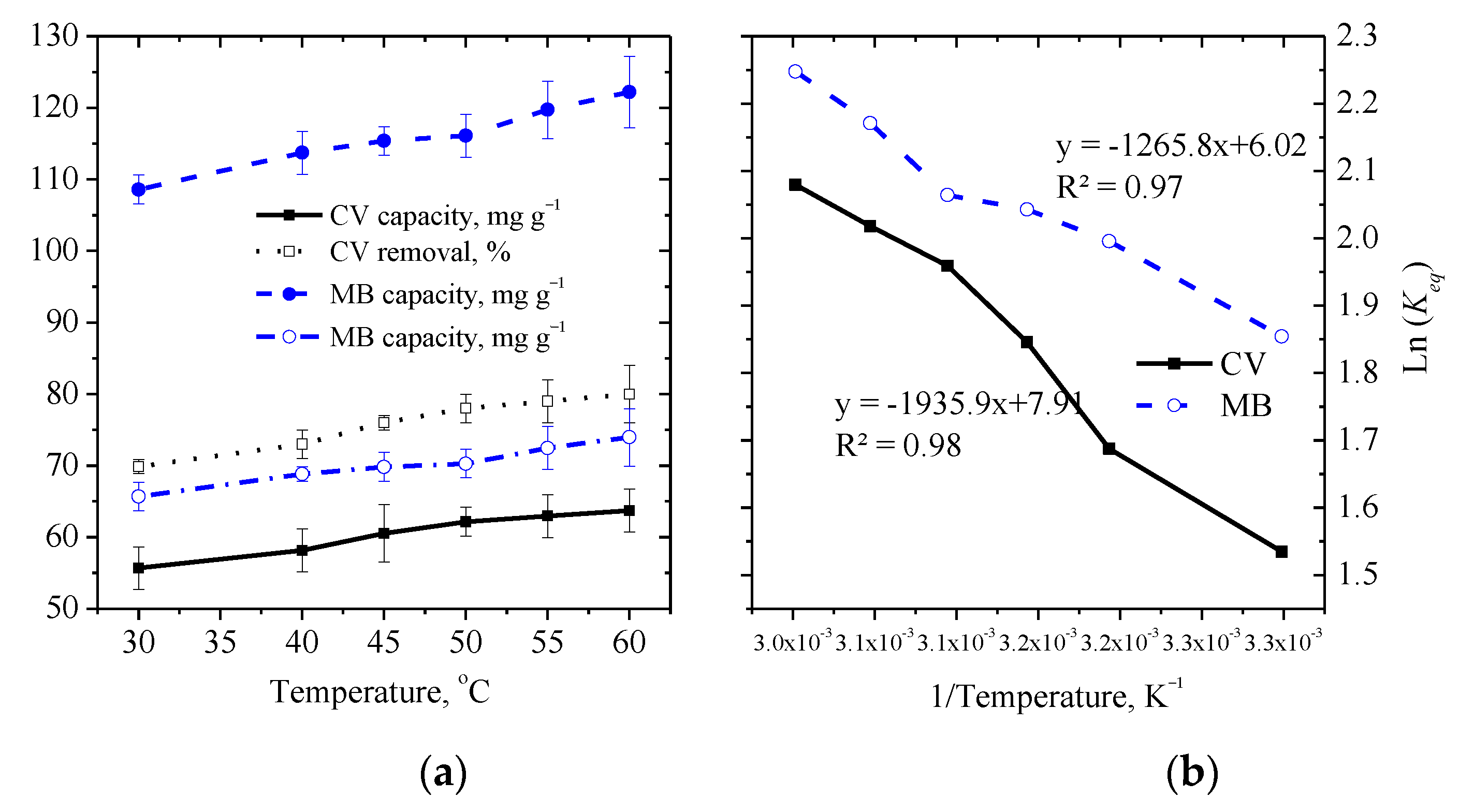


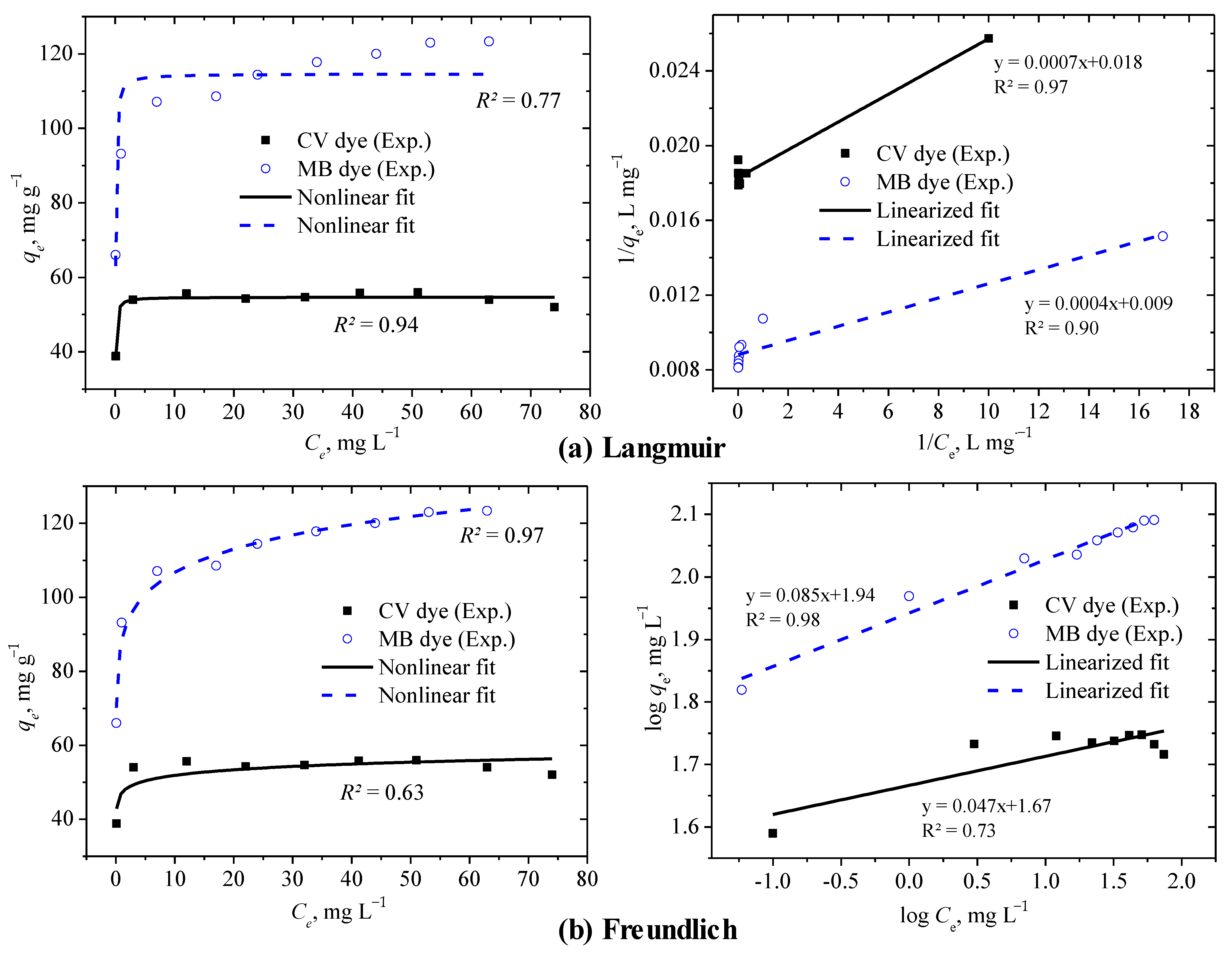
| Model | Nonlinear | Linearized |
|---|---|---|
| Kinetic | ||
| PFO | ||
| PSO | ||
| Elovich | ||
| ID-WM | ||
| Isotherm | ||
| Langmuir | ||
| Freundlich | ||
| D–R | ||
| Halsey | ||
| Temkin | ||
| H–J | ||
| Jovanovic | ||
| Parameter | Temperature, °C | CV Dye | MB Dye |
|---|---|---|---|
| ΔH, kJ·mol−1 | 30–60 | 16.1 | 10.52 |
| ΔS, J·K−1 mol−1 | 0.066 | 0.05 | |
| ΔG, kJ·mol−1 | 30 | −3.84902 | −4.65947 |
| 40 | −4.50691 | −5.16032 | |
| 45 | −4.83586 | −5.41074 | |
| 50 | −5.16481 | −5.66117 | |
| 55 | −5.49376 | −5.9116 | |
| 60 | −5.8227 | −6.16202 |
| Kinetic Model | Parameter | Nonlinear | Linear Fitting | ||||||
|---|---|---|---|---|---|---|---|---|---|
| CV Dye | MB Dye | CV Dye | MB Dye | ||||||
| 20 | 50 | 20 | 50 | 20 | 50 | 20 | 50 | ||
| qe exp (mg g−1) | 38.86 | 55.67 | 66.01 | 108.6 | 38.86 | 55.67 | 66.01 | 108.6 | |
| PFO | qe cal (mg g−1) | 36.85 | 49.93 | 62.69 | 103 | 6.52 | 8.45 | 11.83 | 14.62 |
| k1 (min−1) | 0.24 | 0.41 | 0.25 | 0.19 | 0.019 | 0.003 | 0.017 | 0.009 | |
| R2 | 0.62 | 0.72 | 0.81 | 0.93 | 0.63 | 0.07 | 0.66 | 0.25 | |
| PSO | qe cal (mg g−1) | 39.22 | 48.54 | 65.98 | 108.6 | 38.55 | 51.63 | 66.23 | 103.09 |
| k2 (g mg−1 min−1) | 0.010 | 0.015 | 0.006 | 0.003 | 0.011 | 0.015 | 0.007 | 0.013 | |
| h (mg g1 min−1) | 16.03 | 34.25 | 26.86 | 32.68 | 16.32 | 40.62 | 29.41 | 142.86 | |
| R2 | 1.00 | 1.00 | 0.95 | 0.98 | 0.83 | 0.88 | 1.00 | 1.00 | |
| Elovich | α (mg g−1 min−1) | 329.57 | 9753.8 | 431.21 | 301.19 | 78.65 | 2519.19 | 57.46 | 42.55 |
| β (g mg−1) | 0.24 | 0.24 | 0.13 | 0.07 | 4.24 | 4.12 | 7.50 | 13.68 | |
| R2 | 0.9 | 0.69 | 0.91 | 0.84 | 0.91 | 0.71 | 0.92 | 0.85 | |
| ID–WM | Kip (mg g−1 min1/2) | 1.25 | 1.03 | 2.15 | 3.71 | 1.25 | 1.03 | 2.15 | 3.71 |
| C (mg g−1) | 23.65 | 38.67 | 40.01 | 61.05 | 23.65 | 38.67 | 40.01 | 61.05 | |
| R2 | 0.64 | 0.3 | 0.59 | 0.48 | 0.67 | 0.37 | 0.63 | 0.53 | |
| Isotherm | Parameter | CV Dye | MB Dye | ||
|---|---|---|---|---|---|
| Nonlinear | Linear | Nonlinear | Linear | ||
| qe exp, mg g−1 | 55.92 (against 80 mg L−1) | 123.33 (against 100 mg L−1) | |||
| Langmuir | qm, mg g−1 | 54.7 | 54.64 | 114.6 | 114.6 |
| KL, L mg−1 | 24.59 | 26.14 | 20.68 | 20.68 | |
| RL | 0.0005 | 0.0005 | 0.0005 | 0.0005 | |
| R2 | 0.94 | 0.97 | 0.77 | 0.90 | |
| Freundlich | qm, mg g−1 | 56.19 | 57.11 | 106.99 | 128.3 |
| KF, ((mg/g)(L/mg)1/n) | 47.16 | 46.58 | 88.44 | 86.58 | |
| 1/n | 0.04 | 0.047 | 0.04 | 0.085 | |
| R2 | 0.63 | 0.73 | 0.97 | 0.98 | |
| D–R | qm, mg g−1 | 54.58 | 54.57 | 114.1 | 113.60 |
| KDR, (mol kJ−1)2 | 9.3 × 10−9 | 9.0 × 10−9 | 1.1 × 10−8 | 1.0 × 10−8 | |
| E, kJ mol−1 | 7.33 | 7.45 | 6.80 | 7.07 | |
| R2 | 0.94 | 0.96 | 0.75 | 0.98 | |
| Halsey | qe cal, mg g−1 | 56.06 | 55.76 | 124.19 | 132.14 |
| nH | −18.77 | −21.51 | −12.22 | −11.71 | |
| KH | 0.000 | 0.004 | 0.000 | 0.073 | |
| R2 | 0.58 | 0.73 | 0.97 | 0.98 | |
| Temkin | KT, L mg−1 | 3.23 × 109 | 3.23 × 109 | 8.4 × 104 | 8.4 × 104 |
| Hads, kJ mol−1 | 1172.15 | 1172.16 | 317.53 | 317.53 | |
| R2 | 0.67 | 0.71 | 0.99 | 0.99 | |
| H–J | AHJ, mg g−1 | 1104 | 10,000 | 1059 | 20,000 |
| BHJ | 11.67 | 5 | 6.03 | 2 | |
| R2 | 0.6 | 0.75 | 0.95 | 0.91 | |
| Jovanovic | qm, mg g−1 | 54.54 | 49.61 | 113.42 | 89.22 |
| Kj, L g−1 | −12.47 | −0.002 | −14.78 | −0.007 | |
| R2 | 0.94 | 0.15 | 0.7 | 0.57 | |
| Adsorbent | Textile Dye | Maximum Adsorption Capacity, mg g−1 | Reference |
|---|---|---|---|
| Pine cone biochar | MB | 117.65 | [51] |
| Palm Kernel Shell-Derived Biochar | CV | 24.45 | [52] |
| Date Palm Fronds Waste biochar | MB | 206.61 | [53] |
| Gliricidia sepium wood biochar | CV | 7.9 | [54] |
| Sewage sludge biochar | MB | 24.10 | [55] |
| Spent mushroom substrate biochar | CV | 255 | [56] |
| Date seed biochar | MB | 42.6 | [57] |
| Ec-bio | CV | 56 | This study |
| Ec-bio | MB | 123.3 | This study |
Publisher’s Note: MDPI stays neutral with regard to jurisdictional claims in published maps and institutional affiliations. |
© 2021 by the authors. Licensee MDPI, Basel, Switzerland. This article is an open access article distributed under the terms and conditions of the Creative Commons Attribution (CC BY) license (http://creativecommons.org/licenses/by/4.0/).
Share and Cite
Amin, M.T.; Alazba, A.A.; Shafiq, M. Successful Application of Eucalyptus Camdulensis Biochar in the Batch Adsorption of Crystal Violet and Methylene Blue Dyes from Aqueous Solution. Sustainability 2021, 13, 3600. https://doi.org/10.3390/su13073600
Amin MT, Alazba AA, Shafiq M. Successful Application of Eucalyptus Camdulensis Biochar in the Batch Adsorption of Crystal Violet and Methylene Blue Dyes from Aqueous Solution. Sustainability. 2021; 13(7):3600. https://doi.org/10.3390/su13073600
Chicago/Turabian StyleAmin, Muhammad Tahir, Abdulrahman Ali Alazba, and Muhammad Shafiq. 2021. "Successful Application of Eucalyptus Camdulensis Biochar in the Batch Adsorption of Crystal Violet and Methylene Blue Dyes from Aqueous Solution" Sustainability 13, no. 7: 3600. https://doi.org/10.3390/su13073600
APA StyleAmin, M. T., Alazba, A. A., & Shafiq, M. (2021). Successful Application of Eucalyptus Camdulensis Biochar in the Batch Adsorption of Crystal Violet and Methylene Blue Dyes from Aqueous Solution. Sustainability, 13(7), 3600. https://doi.org/10.3390/su13073600






